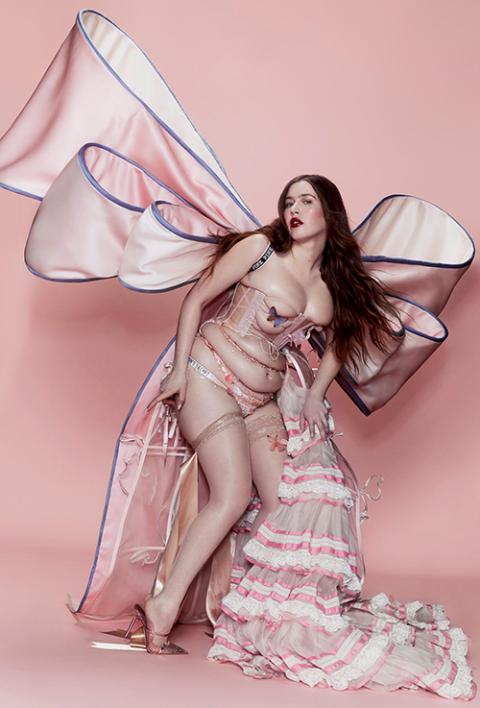
Designs from the Victoria's Secret "Tour '23," from left: Honey Dijon in custom look designed by Bubu Ogisi; Ceval Omar in custom look designed by Michaela Stark; Devyn Garcia in custom look designed by Melissa Duquev; Tess McMillan in custom look designed by Jenny Fax (Photos courtesy of Victoria's Secret)
I hit puberty as the American shopping mall was taking its final, dying breaths. I only entered the hallowed halls of Victoria's Secret to grab bottles of the body spray I'd douse myself with before and after gym class.
Still, I loved the Victoria's Secret Fashion Show. Every year, I'd stake out the family TV after my parents had gone to sleep to watch the rainbow of fantastical outfits and theatrical performances. Growing up in the era of Teen Vogue and "America's Next Top Model," the VS Fashion Show felt like just another arena of fun and style geared toward young women.
It wasn't about sex, it seemed to me. It was about confidence, art and fun. And it was never just underwear: Each model was adorned in layers of costuming designed to accentuate VS products.
The launch of Savage X Fenty in 2018 prophesied the downfall of Victoria's Secret. Through her visionary company, singer-songwriter Rihanna offered inclusion that Victoria sorely lacked. More body types on the runway. More skin tones.
When the Victoria's Secret Fashion Show was canceled in 2019, it aligned with the internet "cancellation" of hegemonic thinness and whiteness, but there was far more going on beneath the surface.
Advertisement
Hulu's 2022 documentary "Victoria's Secret: Angels and Demons" laid bare the connection between the brand, human trafficking and sexual exploitation, a particularly revolting exposé for those who grew up alongside the launch of VS "little sister" brand PINK.
It might seem obvious that lingerie designed and marketed for tweens and teens could have insidious motives. Unfortunately, it can be hard to recognize the sexualizing of children's bodies when our beauty standards for adult women are essentially the same: thin, hairless, petite, cellulite-free, wrinkle-free. And models had long been speaking out about the dangerous dietary and exercise regimens the career-making show required in order to maintain that youthful allure.
Despite this harmful history, Victoria's Secret has been mounting a comeback. Following a restructuring of leadership and a hard-working social media rebrand, Victoria's Secret released a reimagined version of the Fashion Show on Sept. 26. Instead of just one show, "The Tour '23" consists of four separate sister shows curated by teams from four different countries: the U.K., Nigeria, Colombia and Japan, each with its own fashion designer, team of artists and set of models.
Unlike the original shows, the bright lights and bold colors were gone. Set against a naturalistic backdrop of arches and stairwells, the color palette was overwhelmingly beige, black and white. You would think Victoria's Secret had completely abandoned its trademark pink.
Notably, none of the four mini-shows featured VS items. Instead of taking the company's clothes and building inventive fashion atop them, these designers took VS concepts — angels, secrets, womanhood, sexuality — and designed wholly independent looks.
An aggressive social media campaign promised a return of the original supermodels known and loved by Y2K viewers. Relegated to a fleeting five-minute intermission, these "Icons" — the brand's new word for "Angels" — are the only glimpse viewers get of Victoria's Secret clothes.
That same social media campaign seemed to promise improved model diversity. While the cast was certainly less white and LGBTQ representation was high, the fact is, skinny still reigned supreme. By my estimation, only 10% of the cast could be considered "plus-size."
One of the most compelling aspects of the London show was following designer Michaela Stark as she explored the archival VS Fashion Show costumes in Ohio. There's something akin to relief at seeing plus-size models' — and Michaela's own — rolls and loose skin pouring over the edges of the clothes we saw gracing the catwalk a decade ago.
It must also be noted that not a single model in the entire tour appeared to have a disability. This absence of disabled talent is particularly startling, considering the design concept of the Bogotá collection. Inspired by stretch marks, tumors and scars, designer Melissa Valdés explicitly references chronic illness and cancer as her inspiration.
Valdés' pieces — intricately and intimately crocheted by the designer's own mother — form webs reminiscent of spiders, root systems and cells, quite lovely in their own right. But it is troubling that rather than cast models who have stretch marks, scars, chronic illness and cancer and then designing a collection to amplify these real conditions, the designer fabricated stretch marks and scars and placed them on taut, skinny bodies (with the exception of one plus-size model). With our pervasive cultural bias that disabled and ill people are not sexual like everyone else, this exclusion is concerning.
Similarly, the Tokyo collection was created by Jenny Fax with women's aging in mind: What is family, as you get older? How does aging impact your body? How does aging impact your career?

Iris Law in custom look designed by VS20 Tokyo designer Jenny Fax (Courtesy of Victoria's Secret)
To reflect this, the designer made silicone molds of her own body into dresses worn by much skinnier, younger models. Again, if the goal was to represent the aging everywoman's body, why not cast the aging everywoman's body?
It was experimental. It was high fashion. It was performance art.
But was it Victoria's Secret?
The disproportionate emphasis on skinniness said yes.
Reviewers are overwhelmingly saying no, and with a fervor that is revealing:
"VS is the only brand that can get away with exclusivity, and it should stay that way."
"The unattainability is what we loved."
"The fantasy of having the dream body is shattered."
"Armpit hair is not for Angels."
Even 10% larger is too much for many women. For them, the Victoria's Secret fantasy was never the lingerie. It was the smooth, skinny body beneath.
For others — myself included — the disappointment over the show was simply the absence of, well, fun.

Mayowa Micholas in custom look designed by VS20 Lagos-based designer Bubu Ogisi (Courtesy of Victoria's Secret)
"The Tour" has its moments of profundity, particularly in the interview portions. For example, when reflecting on what it means to be a "goddess" — a word long-loved by the brand — the artist for the Lagos collection, Wavy the Creator, says, "We are all extensions of what we've been created from." Imago Dei, indeed.
Meanwhile, Valdés invites us to reconsider the word "secret" as not the lingerie but the changing of the body wearing it, which society often demands be covered up or removed. It is this gaze, the one that demands childlike stasis, that does harm.
Isn't this our essential lesson from Victoria's Secret's history? Expecting an unchanged body leads to pain, manipulation and rejection. Life leaves marks. In the Christian tradition, even God has wounds.
Stark says, "Having the right gaze on your own body is so important." What is the right gaze? Acceptance, joy.
Yet, this new show is not particularly accepting or enjoyable. It would seem Victoria's Secret has resolved to take itself more seriously, ditching the girly pinks it has been known for in favor of something harder, grittier, more engaged with today's issues.
But this serious tone is not even echoed in the framing. Model Gigi Hadid's rom-com-style voice overs used to transition between mini-shows are frustrating and distasteful in contrast to the newfound sincerity of the artistry. Viewers can't help but be confused: Are we supposed to take this seriously?
Most telling of all is that Victoria's Secret's attempt at seriousness is already dated. 2023 has been the year of reclaiming girlhood. Between Taylor Swift, Beyoncé and Barbie, the exact audience VS hopes to recapture is shouting from the rooftops that it wants the girly and the pink. Gray and beige are out. After years of survival mode, female consumers are saying it's time for play.
2023 was the perfect opportunity to reintroduce the Victoria's Secret fashion show. Instead, the company opted for virtue-signaling an inclusiveness that it should have had a decade ago and still can't seem to make good on. VS wants to have its cake and eat it, too ... and still be skinny.
Like all creative efforts, "The Tour" begs questions of intention and purpose: What is the purpose of a lingerie brand's fashion show? Is it to educate us about interculturality, diversity and political unrest — or is it to arouse viewers? Is it the proper platform for discourse on ageism and sexism — or is it a flashy ad? Does Victoria's Secret need to be experimental — or can it just be thoughtful? Must something be serious to be beautiful — or can fun be transcendent precisely because it is fun?
I had high hopes for what many other reviews are calling for: a return to Victoria's Secret with models of various sizes, ethnicities and abilities. While we wait to see if the brand tries again or collapses all together, I think I'll stick with the one thing that hasn't changed: its sickly sweet perfume spray. It goes with every body.







